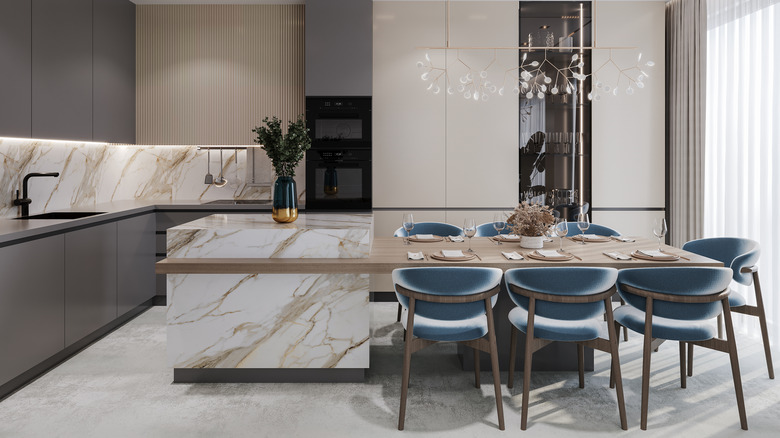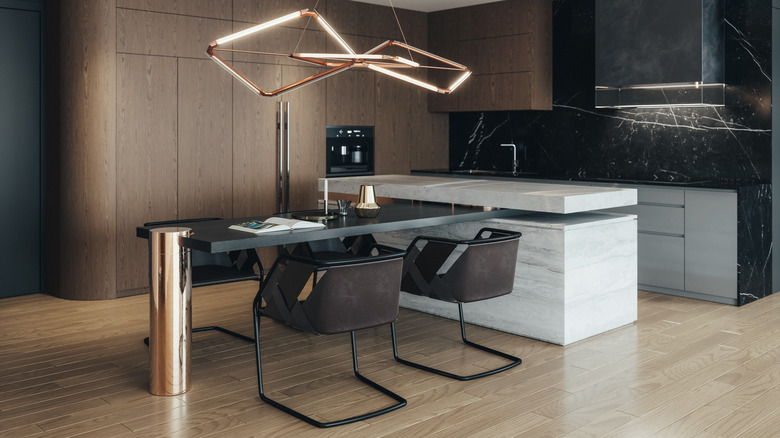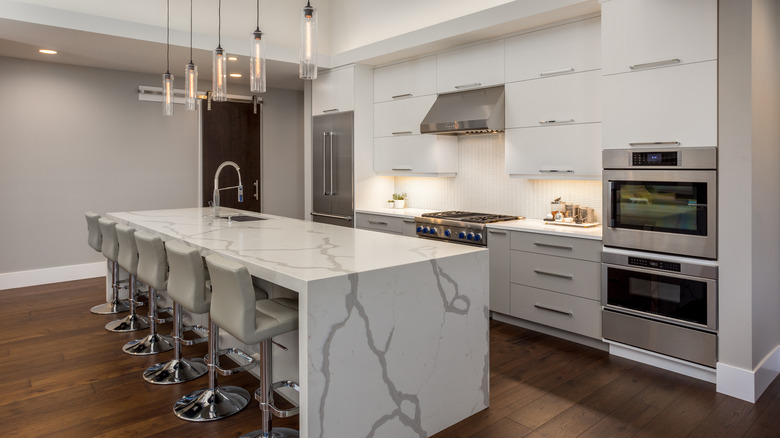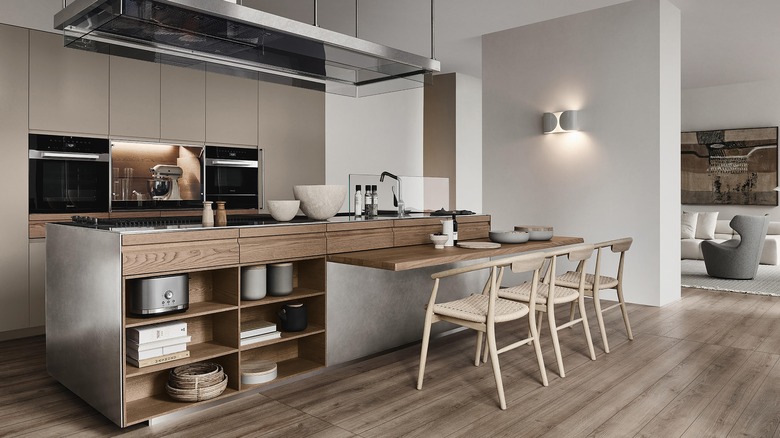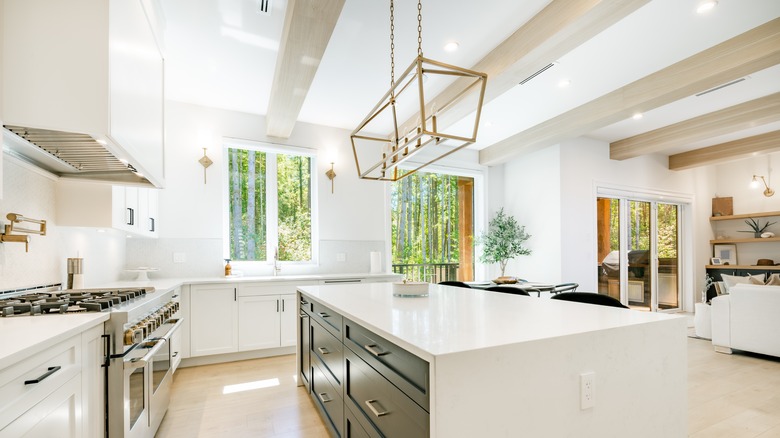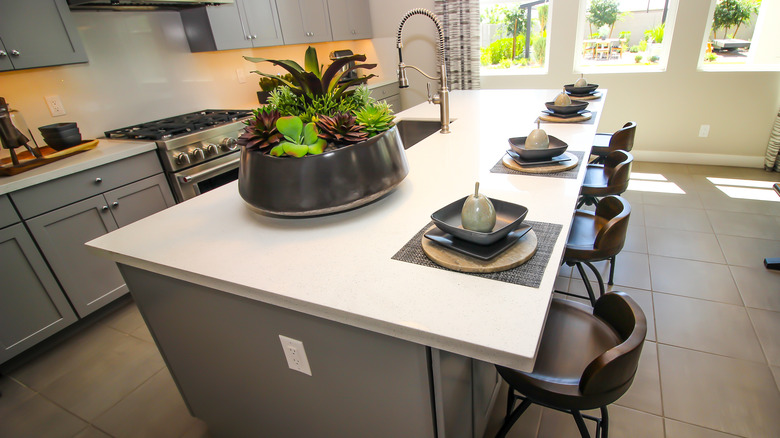Trendy Ways To Design A Kitchen Island That Doubles As A Functioning Dining Table
Kitchen islands have many functions: They serve as a place to prepare food, display meals, and entertain guests. However, in recent times, the island has also doubled as a dining table for many homeowners. This trend has likely emerged because it has become popular to convert your formal dining room into something more useful, like a children's play area or home office. Homeowners have instead started gathering in the kitchen to dine because it's more convenient since the food is cooked right next to the table.
To use your kitchen island as a dining table, it should include an overhanging countertop that extends at least a foot past the rest of your counter so that your seating can fit underneath. You'll also want the top of the seat and the underside of the countertop to be about a foot away from each other. Additionally, if you really want the island to feel like a table, keep it the same height as or slightly lower than adjacent counters.
Trendy types of dining islands
The typical island is rectangular, with storage cabinets on one side and seating on the other. However, if you want to make your island suitable for dining, there are a few innovative ways to do so. For instance, choosing an extra large surface would give your kitchen a modern look while providing more space for additional seating.
Another interesting option recently gaining popularity is including two islands in a kitchen design. If you did this, you could designate one for storage and food prep and the other for dining. Including a walkway between the two surfaces could improve the functionality of the space. Many also add an extension onto their island without any storage space, allowing chairs to slide underneath the countertop easily. If you're debating which layout suits you, consider the size of your kitchen, as there should be at least 3 feet of space around the dining island.
Deciding upon the right seating
Another way to make this kitchen feature look chic is by choosing proper seating. Generally, it's best to use chairs or stools with backs, as they will be more functional and comfortable. They will also make more of a statement in the space since they're larger. If you wish to embrace a kitchen aesthetic that's currently very popular, choose stools or chairs that offer natural materials like wood, cane, and leather. If you wish for them to stand out, upholstered chairs with a pop of color could also upgrade your kitchen's appeal.
When deciding how many seats to place around the island, consider a few factors, including how many people are in your family, how many guests you typically entertain, and how much room you have for each chair. Each seat should be about 1½ to 2 feet apart, so allow for at least this much room. If you have young children in your family, investing in adjustable chairs may be best so that the height can change depending on who's using the seat.
Choosing the right countertop material
The next step to creating a trendy dining island is choosing a suitable countertop material. If you prefer to adopt a rustic, farmhouse, or cozy aesthetic, the best countertop material for your island may be butcher block. This is because it will give your space a natural warmth and charm while making your island look more like a wooden dining table. However, if you prefer a cleaner and more modern look, a simple-looking natural stone surface like white quartz or marble might be ideal, as these can also look more like dining tables since they typically have solid colors and subdued textures.
On the other hand, you may want to avoid other materials when choosing the right countertops. The least desirable material is perhaps stainless steel, as it's known for being more functional than aesthetic. Because it's typically used in restaurants, it has a utilitarian feel that could look cold and unwelcoming as an island dining table. Granite's busy texture may also take away from the look you're going for.
Installing the right lighting
What you hang above your island can also make a massive difference in how it appears. Two or three pendants are typically installed over islands, as these can be ideal for task lighting, which is helpful when cooking and cleaning. However, if you want to create a trendy dining table island, a long chandelier that extends down the length of the table may be a better option. This is because one chandelier will make more of a statement than several pendants, as it's usually more decorative. When installing, the bottom of the light fixture should be at least 2½ feet away from the top of your island.
Further, while you might still require task lighting, you may also want your kitchen lighting to create a peaceful ambiance during mealtime. Because of this, it's best to add dimmable light switches. You also want your light bulbs to give off a warm glow instead of a harsher blue hue, as this will benefit the mood of the space.
Decorating the surface
Typically, islands are decorated with something simple like a fruit bowl or a flower vase, which could sit in the middle of the surface. This is because islands are primarily used for preparing food or snacking. However, if you want to use this surface like a dining table, you can add additional decorative items, making it look more formal and inviting people to sit and eat.
For instance, placemats, elegantly folded cloth napkins, and dishes can go a long way when transforming an island into a dining table. These will emphasize how the space is used for eating. Another great idea is adding a long centerpiece down the length of the surface, like a table runner, a garland, or a collection of candles. This will draw attention to the size of your table and make it look more like a separate furniture piece instead of just an extension of your other kitchen countertops. That said, less is more when decorating a smaller kitchen island primarily used for enjoying meals.
